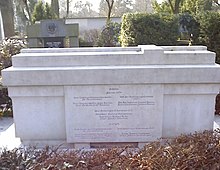Josef Beyerl
Josef Beyerl (born July 9, 1898 in Leopoldschlag , Upper Austria ; † July 27, 1934 in Wilhering , Upper Austria) was an Austrian gendarmerie inspector and a victim of National Socialism.
Live and act
At the age of 17, Beyerl volunteered for the Upper Austrian young riflemen and participated in the First World War as a member of the 14th Infantry Regiment until the end of the war. He then worked as a gendarme at the Haslach an der Mühl post , Peilstein im Mühlviertel and from 1930 at the Wilhering gendarmerie post . In 1934 he was assigned to the magazine administration of the Provincial Gendarmerie Command for Upper Austria; due to a case of illness, however, he voluntarily reported back to Wilhering, where he died a few days after starting work. Beyerl was married to his wife Franziska (born January 10, 1902, † November 22, 1968) and left behind the children Richard and Isolde at the age of nine and ten. With great public sympathy, Gendarmerie Bayon Inspector Beyerl was brought to rest on July 30, 1934 in Wilhering.
Alongside district inspector Richard Hölzel and gendarme Josef Maria Lukesch, Bayerl is one of the three gendarmerie officers who lost their lives in the July coup of the National Socialists in Upper Austria in 1934 .
assassination
The so-called July coup of the NSDAP , which had been banned in Austria since June 19, 1933, which began in Vienna on July 25, 1934 , also spread to Upper Austria. Following the pattern outlined in the so-called Kollerschlager Document , attempts were also made there to take over power from the National Socialists in town halls and public institutions.
On July 27, 1934 at 1.30 a.m., the Wilhering gendarmerie was reported that there were suspicious activities in the neighboring village of Ufer. Thereupon Beyerl went to the bank together with several local guards and the post commander, Revierinspektor Schachner, who had been notified in an alcove. Four people were arrested there and locked in the Banwinkler Inn. At 2.30 a.m., a Schutzkorpsmann reported that an armed group was on the hill above the Banwinkler inn. Beyerl then went up to the hill with two local security guards, and Revierinspektor Schachner and other protective corpsmen proceeded against the group on the other side of the hill. The putschists then opened fire and Beyerl was hit by four rifle shots in the arm and in the stomach. His companions carried him down to the street, where he succumbed to his severe wounds half an hour later. At dawn, 35 Mannlicher rifles were found in a ditch; 25 were loaded, ten of which were still wrapped in paper.
Those involved in the uprising were arrested - as far as their names were known - and convicted of having participated in the coup. The Beyerl murderer (s) could not be identified in the trials, i. H. in this case, too, the perpetrators were never tried.
Honors
Beyerl was posthumously awarded the gold medal for services to the federal state of Austria on August 6, 1934 by Federal President Wilhelm Miklas .
On November 11, 1934, the unveiling of the memorial for the fallen gendarmerie officer took place in the presence of Governor Heinrich Gleißner as well as other high-ranking officials and with great public participation. The memorial was erected at the place where Beyerl died in Wilhering-Ufer (today Linzerstraße 51).
It was also in Linz built at Barbara Cemetery on May 23, 1935, a monument to the fallen in February 1934 (uprising of the Social Democrats) and July 1934 (July Putsch) army members, police officers and Civic Guards, was designed with the well Gendarmerie Rayon Inspector Joseph Beyerl. The monument was renovated in 2010.
Individual evidence
- ^ Bauer, Kurt (2001). Social-historical aspects of the National Socialist July coup 1934. Dissertation: Faculty of Humanities and Cultural Studies at the University of Vienna (p. 344).
- ↑ Wilhering market town (ed.). (2006). Wilhering (Volume 2, compiled by H. Heisler with numerous photo contributions by Anton S. Kehrer). Denkmayr.
- ↑ Wilheringer Community Chronicle (1934). National Socialist Party - July Revolt (pages 79-81).
| personal data | |
|---|---|
| SURNAME | Beyerl, Josef |
| BRIEF DESCRIPTION | Austrian gendarmerie inspector |
| DATE OF BIRTH | July 9, 1898 |
| PLACE OF BIRTH | Leopoldschlag |
| DATE OF DEATH | July 27, 1934 |
| Place of death | Wilhering |


